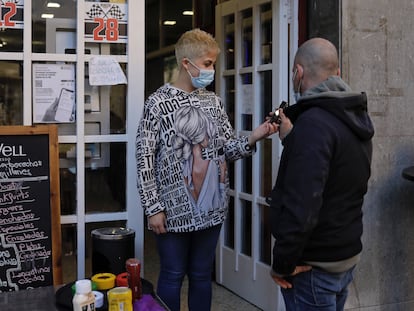In Spain, relief over Covid slowdown is offset by spike among children
Infection data on the sixth coronavirus wave confirm that it is flattening, but a new flare-up caused by high transmission among minors cannot be ruled out yet

The sixth coronavirus wave in Spain is slowing. This can be clearly seen in the national data: the number of daily cases is stabilizing, and more importantly still, so too are hospital admissions for Covid-19, which is a more reliable sign of the change in trend.
There are regions, such as Navarre and the Basque Country, where the number of detected infections is clearly falling.
And there is another sign that contagions are falling beyond the official case count: the presence of the virus in wastewater. In Madrid, the concentration of SARS-CoV-2 has dropped 25% in the last two weeks. It is an important sign because it does not depend on how many tests are carried out and how many positives are reported, which is a changing protocol.
Looking at the figures, it could be said that cases are falling and that they will continue to do so. But there is another data point that raises concern.
Coronavirus cases are rising very quickly among children. This can be seen at a national level. Since Kings Day on January 6, the number of infections detected among children and teenagers has started to rise again. For children under the age of nine, the seven-day incidence rate has gone from 1,300 cases per 100,000 inhabitants to 1,900 in just a week.
This trend can be seen in data from Catalonia: cases among children shot up in the second week of January.
The problem is how to interpret these spikes. One possibility is that they simply reflect a rise in contagions following the national holiday and return to school. But it could also be that what has risen is not the number of cases, but rather the number of cases being detected.
Has there been a change in protocols that has improved the detection of infections among children since Christmas? Or has the return to schools, which have guidelines on reporting cases, led to more cases being detected? Researcher Clara Prats, from Catalonia’s Polytechnic University, provided data that would suggest this has been the case: the positivity rate among children – i.e. the percentage of Covid-19 tests that come back positive out of the total – has fallen from 50% in December to 25%. In other words, more cases are being detected, in part because more tests are being carried out.
“We are in the most difficult moment to say anything,” said Saúl Ares, a systems biologist and investigator at Spain’s National Research Council (CSIC), after studying the epidemiological curve. To solve the puzzle, we will have to wait to see how key data points evolve this week: the incidence rate among children, the incidence rate among their parents and the rate of Covid-19 hospital admissions.
How many people have had the virus? In two months, 3.5 million coronavirus cases have been detected in Spain, but the real number could be three or five times higher, i.e. between 10 and 15 million. The United Kingdom carries out random surveys and these suggest that there are three contagions for every case detected. Meanwhile in the United States, some epidemiologists argue that there are four or five infections for every one reported. Spain has a higher positivity rate than both those nations, meaning detection in the country could be even worse.
Between 20% and 30% of Spaniards may have had Covid-19 between November and now. And this figure could double as the sixth wave descends.
These are tremendous figures. As biologist Trevor Bedford explained on Twitter, speaking in reference to the US: “Having around 40% of the population infected by a single pathogen in the span of eight weeks is remarkable and I can’t think of an obvious modern precedent.”
Covid-19 vaccines and the fact that the highly transmissible omicron variant is less severe than previous strains has helped buffer the impact of the virus. But it is important to look closely at the number of hospitalizations and fatalities if we are to consider a future scenario in which Covid-19 is pandemic, predictable and cyclical.
Since November, there have been 68,000 hospital admissions for Covid-19, while 3,500 people have died after testing positive for the virus. Fatalities, however, are typically notified with delays. And since July? Although many people were vaccinated by July, since then, there have been 150,000 hospitalizations, 11,000 official deaths and thousands more excess deaths, according to the National Institute of Statistics (INE).
It’s too soon to compare the virus to the flu, given that this wave has yet to end and that many of the cases detected were due to delta, not omicron. That said, it is useful to have a point of reference. According to the US Centers for Disease Control and Prevention, the flu kills in the US around 32,000 people a year, which for the population in Spain, would be the equivalent to around 4,000 or 5,000 victims. According to the European equivalent, more than 43,000 people die every year from the flu, which would also equal between 4,000 and 5,000 deaths in Spain.
For now Covid is too unpredictable to treat as a flu. As epidemiologist Adam Kucharski explained on Twitter: “A key feature of endemicity is an element of predictability – we understand what’s driving the long term dynamics, and can have some confidence about the range of likely annual outcomes.” This implies certain understanding and control as we have with the flu. But it is not clear if we are at this point with Covid-19.
How many hospital admissions and deaths from Covid-19 could there be in 2023 and 2024? How likely is it that a worse variant of the virus will emerge? These uncertainties do not mean the future is bleak, nor stop us from moving towards a more normal life, but they are reasons to remain vigilant.
Tu suscripción se está usando en otro dispositivo
¿Quieres añadir otro usuario a tu suscripción?
Si continúas leyendo en este dispositivo, no se podrá leer en el otro.
FlechaTu suscripción se está usando en otro dispositivo y solo puedes acceder a EL PAÍS desde un dispositivo a la vez.
Si quieres compartir tu cuenta, cambia tu suscripción a la modalidad Premium, así podrás añadir otro usuario. Cada uno accederá con su propia cuenta de email, lo que os permitirá personalizar vuestra experiencia en EL PAÍS.
¿Tienes una suscripción de empresa? Accede aquí para contratar más cuentas.
En el caso de no saber quién está usando tu cuenta, te recomendamos cambiar tu contraseña aquí.
Si decides continuar compartiendo tu cuenta, este mensaje se mostrará en tu dispositivo y en el de la otra persona que está usando tu cuenta de forma indefinida, afectando a tu experiencia de lectura. Puedes consultar aquí los términos y condiciones de la suscripción digital.
More information
Últimas noticias
Sydney Sweeney, the actress praised by Trump: ‘Women are up against what society wants them to be’
The Bolsonaro surname: An advantage or liability in Brazil’s 2026 presidential elections?
Raúl Rocha, from jet-setting with Miss Universe to arms trafficking and fuel theft
80,000 barrels of Mexican oil sent to Cuba: Havana drawn into the US–Mexico clash
Most viewed
- Reinhard Genzel, Nobel laureate in physics: ‘One-minute videos will never give you the truth’
- Pablo Escobar’s hippos: A serious environmental problem, 40 years on
- Charles Dubouloz, mountaineering star, retires at 36 with a farewell tour inspired by Walter Bonatti
- Why we lost the habit of sleeping in two segments and how that changed our sense of time
- The fall of a prolific science journal exposes the billion-dollar profits of scientific publishing











































